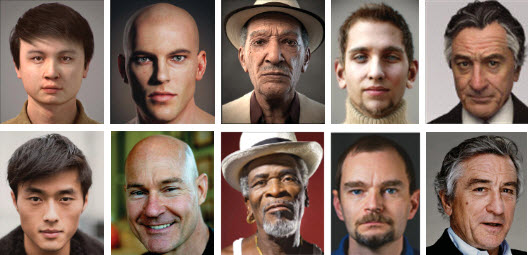Real or computer-generated: can you tell the difference?
February 22, 2016

Which of these are photos vs. computer-generated images? (credit: Olivia Holmes et al./ACM Transactions on Applied Perception) (credit: Olivia Holmes et al./ACM Transactions on Applied Perception)
As computer-generated characters become increasingly photorealistic, people are finding it harder to distinguish between real and computer-generated, a Dartmouth College-led study has found.
This has introduced complex forensic and legal issues*, such as how to distinguish between computer-generated and photographic images of child pornography, says Hany Farid, a professor of computer science, pioneering researcher in digital forensics at Dartmouth, and senior author of a paper in the journal ACM Transactions on Applied Perception.
“This can be problematic when a photograph is introduced into a court of law and the jury has to assess its authenticity,” Farid says.
Training helps … for now
In their study, Farid’s team conducted perceptual experiments in which 60 high-quality computer-generated and photographic images of men’s and women’s faces were shown to 250 observers. Each observer was asked to classify each image as either computer generated or photographic. Observers correctly classified photographic images 92 percent of the time, but correctly classified computer-generated images only 60 percent of the time.

The top row images are all computer-generated, paired here with their photographic matches below (credit: Olivia Holmes et al./ACM Transactions on Applied Perception)
But in a follow-up experiment, when the researchers provided a second set of observers with some training before the experiment, their accuracy on classifying photographic images fell slightly to 85 percent but their accuracy on computer-generated images jumped to 76 percent.
With or without training, observers performed much worse than Farid’s team observed five years ago in a study when computer-generated imagery was not as photorealistic.
When humans can no longer judge what’s real
“We expect that human observers will be able to continue to perform this task for a few years to come, but eventually we will have to refine existing techniques and develop new computational methods that can detect fine-grained image details that may not be identifiable by the human visual system,” says Farid.
The study, which included Dartmouth student Olivia Holmes and Professor Martin Banks at the University of California, Berkeley, was supported by the National Science Foundation.
* Legal background
- In 1996, Congress passed the Child Pornography Prevention Act (CPPA), which made illegal “any visual depiction including any photograph, film, video, picture or computer-generated image that is, or appears to be, of a minor engaging in sexually explicit conduct.”
- In 2002, the U.S. Supreme Court ruled that the CPPA infringed on the First Amendment and classified computer-generated child pornography as protected speech. As a result, defense attorneys need only claim their client’s images of child pornography are computer generated.
- In 2003, Congress passed the PROTECT Act, which classified computer generated child pornography as “obscene,” but this law didn’t eliminate the so-called “virtual defense” because juries are reluctant to send a defendant to prison for merely possessing computer-generated imagery when no real child was harmed.
Abstract of Assessing and Improving the Identification of Computer-Generated Portraits
Modern computer graphics are capable of generating highly photorealistic images. Although this can be considered a success for the computer graphics community, it has given rise to complex forensic and legal issues. A compelling example comes from the need to distinguish between computer-generated and photographic images as it pertains to the legality and prosecution of child pornography in the United States. We performed psychophysical experiments to determine the accuracy with which observers are capable of distinguishing computer-generated from photographic images. We find that observers have considerable difficulty performing this task—more difficulty than we observed 5 years ago when computer-generated imagery was not as photorealistic. We also find that observers are more likely to report that an image is photographic rather than computer generated, and that resolution has surprisingly little effect on performance. Finally, we find that a small amount of training greatly improves accuracy.